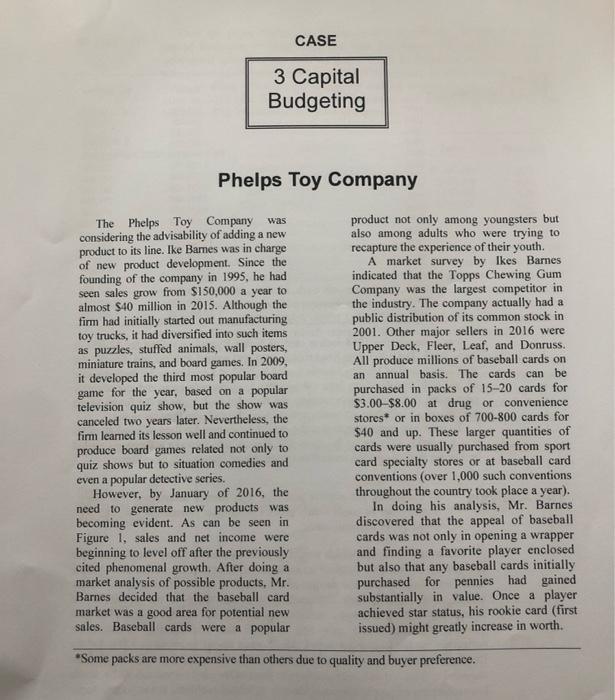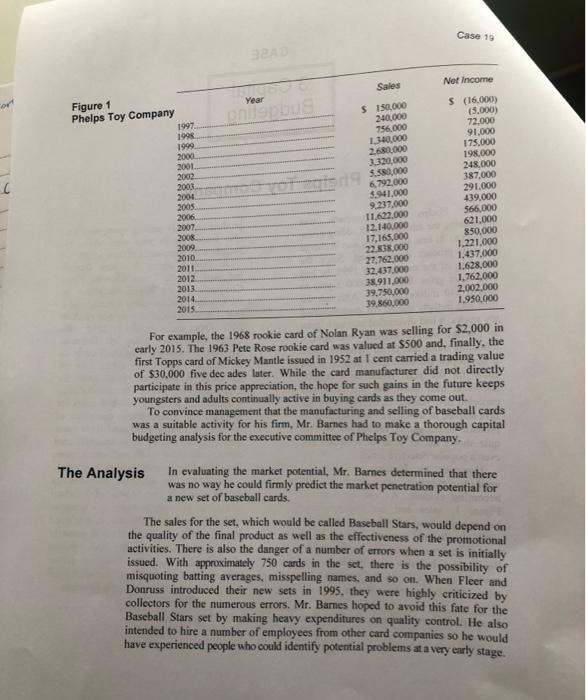CASE 3 Capital Budgeting Phelps Toy Company The Phelps Toy Company was considering the advisability of adding a new product to its line. Ike Bames was in charge of new product development. Since the founding of the company in 1995, he had seen sales grow from $150,000 a year to almost $40 million in 2015. Although the firm had initially started out manufacturing toy trucks, it had diversified into such items as puzzles, stuffed animals, wall posters, miniature trains, and board games. In 2009, it developed the third most popular board game for the year, based on a popular television quiz show, but the show was canceled two years later. Nevertheless, the firm leamed its lesson well and continued to produce board games related not only to quiz shows but to situation comedies and even a popular detective series. However, by January of 2016, the need to generate new products was becoming evident. As can be seen in Figure 1. sales and net income were beginning to level off after the previously cited phenomenal growth. After doing a market analysis of possible products, Mr. Barnes decided that the baseball card market was a good area for potential new sales. Baseball cards were a popular product not only among youngsters but also among adults who were trying to recapture the experience of their youth. A market survey by Ikes Barnes indicated that the Topps Chewing Gum Company was the largest competitor in the industry. The company actually had a public distribution of its common stock in 2001. Other major sellers in 2016 were Upper Deck, Fleer, Leaf, and Donruss. All produce millions of baseball cards on an annual basis. The cards can be purchased in packs of 15-20 cards for $3.00-$8.00 at drug or convenience stores or in boxes of 700-800 cards for $40 and up. These larger quantities of cards were usually purchased from sport card specialty stores or at baseball card conventions (over 1,000 such conventions throughout the country took place a year). In doing his analysis, Mr. Barnes discovered that the appeal of baseball cards was not only in opening a wrapper and finding a favorite player enclosed but also that any baseball cards initially purchased for pennies had gained substantially in value. Once a player achieved star status, his rookie card (first issued) might greatly increase in worth. *Some packs are more expensive than others due to quality and buyer preference. Case 19 22 Sales Year Figure 1 Phelps Toy Company 1997 1998 1999 $ 150,000 240.000 756.000 1.340.000 2.680.000 3.320,000 2000 2001 2002 C 2003 2004 2005 2006 2007 2008 2009 2010 2011 2012 2013 2014 2015 6,792.000 3.941.000 9.237.000 11.622.000 12.140.000 17,165.000 22.835.000 27.762.000 32.437.000 38,911,000 39,750,000 39.860,000 Net Income $ (16,000) (5.000) 72.000 91.000 175.000 198,000 248.000 387.000 291.000 439.000 566,000 621.000 850,000 1.221.000 1.437.000 1.628.000 1,762,000 2.002,000 1.950,000 For example, the 1968 rookie card of Nolan Ryan was selling for $2,000 in early 2015. The 1963 Pete Rose rookie card was valued at $500 and, finally, the first Topps card of Mickey Mantle issued in 1952 at 1 cent carried a trading value of $30,000 five decades later. While the card manufacturer did not directly participate in this price appreciation, the hope for such gains in the future keeps youngsters and adults continually active in buying cards as they come out. To convince management that the manufacturing and selling of baseball cards was a suitable activity for his firm, Mr. Barnes had to make a thorough capital budgeting analysis for the executive committee of Phelps Toy Company, The Analysis In evaluating the market potential. Mr. Barnes determined that there was no way he could firmly predict the market penetration potential for a new set of baseball cards. The sales for the set, which would be called Baseball Stars, would depend on the quality of the final product as well as the effectiveness of the promotional activities. There is also the danger of a number of errors when a set is initially issued. With approximately 750 cards in the set, there is the possibility of misquoting batting averages, misspelling names, and so on. When Fleer and Donruss introduced their new sets in 1995, they were highly criticized by collectors for the numerous errors. Mr. Barnes hoped to avoid this fate for the Baseball Stars set by making heavy expenditures on quality control. He also intended to hire a number of employees from other card companies so he would have experienced people who could identify potential problems at a very early stage. Phelps Toy Company Over the years, Phelps Toy Company had developed a manual to evaluate capital budgeting projects. As a first step. Ike Barnes was required to predict anticipated sales over the next six years. While he thought this was too short a time period to evaluate the full potential of the project, he knew he had no choice but to go along with company policy. He decided to project a range for potential sales in 2016 (the first new year of business) and assign probabilities to the outcomes. The information is shown in Figure 2. Figure 2 Projected first-year sales Assumption Pessimistic Normal Optimistic Highly optimistic Sales Probability $1,100,000 2,000,000 3,750,000 4.500.000 0.25 0.40 0.20 015 1.00 It was his intention to determine the expected value for sales for the first year and then project a 20 percent growth rate for the next three years and 10 percent for the final two years. Operating expenses, which were expected to average 70 percent of sales, would then be subtracted to determine earnings before depreciation and taxes. The primary investment to be made was in printing and production equipment, which would fall into the five-year MACRS depreciation category. The equipment, which represents the investment for the project, costs $2.8 million Mr. Barnes looked into the capital budgeting manual to determine the appropriate discount rate (as shown in Figure 3). The discount rate for the project is based on the coefficient of variation of the first year's sales. One of the accounting assistants informed him that the standard deviation of first year's sales was $1,226,000. He knew he could easily determine the expected value from the data previously presented in Figure 2). Mr. Barnes thought that it was now time to call his assistants together to do the appropriate analysis. Coefficient of Variation Discount Rate Figure 3 Discount rate determination 0 - 20 21- 40 .41-60 .61-80 Over 80 89 10 14 16 20 CASE 3 Capital Budgeting Phelps Toy Company The Phelps Toy Company was considering the advisability of adding a new product to its line. Ike Bames was in charge of new product development. Since the founding of the company in 1995, he had seen sales grow from $150,000 a year to almost $40 million in 2015. Although the firm had initially started out manufacturing toy trucks, it had diversified into such items as puzzles, stuffed animals, wall posters, miniature trains, and board games. In 2009, it developed the third most popular board game for the year, based on a popular television quiz show, but the show was canceled two years later. Nevertheless, the firm leamed its lesson well and continued to produce board games related not only to quiz shows but to situation comedies and even a popular detective series. However, by January of 2016, the need to generate new products was becoming evident. As can be seen in Figure 1. sales and net income were beginning to level off after the previously cited phenomenal growth. After doing a market analysis of possible products, Mr. Barnes decided that the baseball card market was a good area for potential new sales. Baseball cards were a popular product not only among youngsters but also among adults who were trying to recapture the experience of their youth. A market survey by Ikes Barnes indicated that the Topps Chewing Gum Company was the largest competitor in the industry. The company actually had a public distribution of its common stock in 2001. Other major sellers in 2016 were Upper Deck, Fleer, Leaf, and Donruss. All produce millions of baseball cards on an annual basis. The cards can be purchased in packs of 15-20 cards for $3.00-$8.00 at drug or convenience stores or in boxes of 700-800 cards for $40 and up. These larger quantities of cards were usually purchased from sport card specialty stores or at baseball card conventions (over 1,000 such conventions throughout the country took place a year). In doing his analysis, Mr. Barnes discovered that the appeal of baseball cards was not only in opening a wrapper and finding a favorite player enclosed but also that any baseball cards initially purchased for pennies had gained substantially in value. Once a player achieved star status, his rookie card (first issued) might greatly increase in worth. *Some packs are more expensive than others due to quality and buyer preference. Case 19 22 Sales Year Figure 1 Phelps Toy Company 1997 1998 1999 $ 150,000 240.000 756.000 1.340.000 2.680.000 3.320,000 2000 2001 2002 C 2003 2004 2005 2006 2007 2008 2009 2010 2011 2012 2013 2014 2015 6,792.000 3.941.000 9.237.000 11.622.000 12.140.000 17,165.000 22.835.000 27.762.000 32.437.000 38,911,000 39,750,000 39.860,000 Net Income $ (16,000) (5.000) 72.000 91.000 175.000 198,000 248.000 387.000 291.000 439.000 566,000 621.000 850,000 1.221.000 1.437.000 1.628.000 1,762,000 2.002,000 1.950,000 For example, the 1968 rookie card of Nolan Ryan was selling for $2,000 in early 2015. The 1963 Pete Rose rookie card was valued at $500 and, finally, the first Topps card of Mickey Mantle issued in 1952 at 1 cent carried a trading value of $30,000 five decades later. While the card manufacturer did not directly participate in this price appreciation, the hope for such gains in the future keeps youngsters and adults continually active in buying cards as they come out. To convince management that the manufacturing and selling of baseball cards was a suitable activity for his firm, Mr. Barnes had to make a thorough capital budgeting analysis for the executive committee of Phelps Toy Company, The Analysis In evaluating the market potential. Mr. Barnes determined that there was no way he could firmly predict the market penetration potential for a new set of baseball cards. The sales for the set, which would be called Baseball Stars, would depend on the quality of the final product as well as the effectiveness of the promotional activities. There is also the danger of a number of errors when a set is initially issued. With approximately 750 cards in the set, there is the possibility of misquoting batting averages, misspelling names, and so on. When Fleer and Donruss introduced their new sets in 1995, they were highly criticized by collectors for the numerous errors. Mr. Barnes hoped to avoid this fate for the Baseball Stars set by making heavy expenditures on quality control. He also intended to hire a number of employees from other card companies so he would have experienced people who could identify potential problems at a very early stage. Phelps Toy Company Over the years, Phelps Toy Company had developed a manual to evaluate capital budgeting projects. As a first step. Ike Barnes was required to predict anticipated sales over the next six years. While he thought this was too short a time period to evaluate the full potential of the project, he knew he had no choice but to go along with company policy. He decided to project a range for potential sales in 2016 (the first new year of business) and assign probabilities to the outcomes. The information is shown in Figure 2. Figure 2 Projected first-year sales Assumption Pessimistic Normal Optimistic Highly optimistic Sales Probability $1,100,000 2,000,000 3,750,000 4.500.000 0.25 0.40 0.20 015 1.00 It was his intention to determine the expected value for sales for the first year and then project a 20 percent growth rate for the next three years and 10 percent for the final two years. Operating expenses, which were expected to average 70 percent of sales, would then be subtracted to determine earnings before depreciation and taxes. The primary investment to be made was in printing and production equipment, which would fall into the five-year MACRS depreciation category. The equipment, which represents the investment for the project, costs $2.8 million Mr. Barnes looked into the capital budgeting manual to determine the appropriate discount rate (as shown in Figure 3). The discount rate for the project is based on the coefficient of variation of the first year's sales. One of the accounting assistants informed him that the standard deviation of first year's sales was $1,226,000. He knew he could easily determine the expected value from the data previously presented in Figure 2). Mr. Barnes thought that it was now time to call his assistants together to do the appropriate analysis. Coefficient of Variation Discount Rate Figure 3 Discount rate determination 0 - 20 21- 40 .41-60 .61-80 Over 80 89 10 14 16 20









